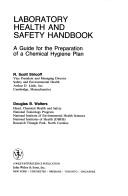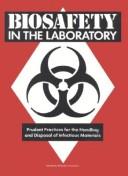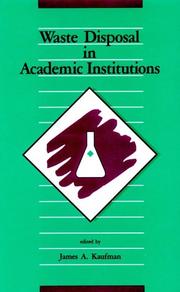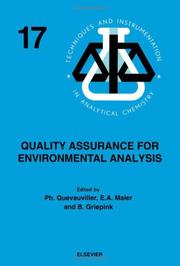| Listing 1 - 10 of 19 | << page >> |
Sort by
|

ISBN: 0471617563 Year: 1990 Publisher: New York Wiley
Abstract | Keywords | Export | Availability | Bookmark
 Loading...
Loading...Choose an application
- Reference Manager
- EndNote
- RefWorks (Direct export to RefWorks)
Chemical laboratories --- Chemistry laboratories --- Laboratories --- Safety measures&delete& --- Handbooks, manuals, etc --- Safety measures

ISBN: 030903390X 9780309033909 Year: 1983 Publisher: Washington, D.C.: National academy press,
Abstract | Keywords | Export | Availability | Bookmark
 Loading...
Loading...Choose an application
- Reference Manager
- EndNote
- RefWorks (Direct export to RefWorks)
#ABIB:adid --- Chemical laboratories --- Chemistry laboratories --- Laboratories --- Waste disposal --- Monograph --- Chemical laboratories - Waste disposal
Book

ISBN: 2759818861 9782759818860 Year: 2015 Publisher: Les Ullis Cedex A, France : EDP Sciences,
Abstract | Keywords | Export | Availability | Bookmark
 Loading...
Loading...Choose an application
- Reference Manager
- EndNote
- RefWorks (Direct export to RefWorks)
Vers un nouveau « business model » de la biologie médicale La réforme de la biologie et son corollaire – l’accréditation – a provoqué une concentration du secteur de la biologie médicale, marquée par une forte réduction du nombre des entités juridiques et une augmentation de leur taille moyenne. Les regroupements sont en effet apparus aux acteurs de la biologie médicale comme inévitables pour faire face aux enjeux futurs du secteur, à savoir : conformité médicale et efficience de la gestion dans un cadre tarifaire contraint. Dans cet ouvrage, biologistes, syndicats, avocats, financiers, experts-comptables et banquiers livrent leurs expertises. Ils partagent les clés de leurs réussites mais aussi les échecs auxquels ils ont été confrontés. Dans ces nouvelles structures nées de processus de fusions/acquisitions complexes, mettant en oeuvre l’ingénierie juridique, financière, fiscale d’autres secteurs d’activité, les biologistes comprennent qu’ils quittent leur ancien mode d’exercice libéral. La mise en place d’une gouvernance dynamique avec son organigramme définissant responsabilités et obligations devient essentielle pour assurer le management des laboratoires multisites. Ainsi, organiser la gouvernance du laboratoire revient à s’accorder sur les fonctions de(s) dirigeant(s), se répartir l’exercice des pouvoirs de gestion et de management, favoriser la circulation de l’information au sein de la structure et rechercher l’adhésion des biologistes et du personnel, en vue de la création de valeur de l’entité : un défi, une révolution auxquels ne prépare pas la formation universitaire médicale. Dans ce livre qui se veut tout à la fois témoignage et vade-mecum à l’usage des biologistes, les auteurs évoquent aussi les perspectives d’évolution de la biologie médicale française. Les contours du nouveau « business model » du secteur ne sont en effet, à ce jour, pas encore totalement tracés. La première étape touchait, le regroupement des structures juridiques. Il était ainsi essentiellement quantitatif. La seconde étape sera cette fois plus qualitative ; comment concilier le respect des normes de l’accréditation, les baisses successives de nomenclatures, la maîtrise des coûts de production et de services proposées par les techniques du Lean Management et l’évolution de la discipline médicale notamment permise par le Big Data et enjeux de recherche des biotech et laboratoires mondiaux ? Mais si l’efficience est désormais indispensable au sein du laboratoire de biologie médicale, chacun doit cependant garder en tête que le coeur du métier de biologiste n’est pas « la course aux tubes », mais bien la réponse à une demande de diagnostic en vue de rendre le meilleur service médical aux patients.

ISBN: 0873712560 Year: 1990 Publisher: Chelsea, Mich. Lewis
Abstract | Keywords | Export | Availability | Bookmark
 Loading...
Loading...Choose an application
- Reference Manager
- EndNote
- RefWorks (Direct export to RefWorks)
Environmental protection. Environmental technology --- Chemical laboratories --- -Chemistry laboratories --- Laboratories --- Waste disposal --- -Congresses --- Agrotechnology and Food Sciences. Engineering --- Congresses. --- Waste treatment --- -Waste disposal --- Waste treatment. --- Chemistry laboratories --- Waste disposal&delete& --- Congresses
Book
ISBN: 9264014101 Year: 2005 Publisher: Paris : OCDE-Organisation de cooperation et developpement economiques,
Abstract | Keywords | Export | Availability | Bookmark
 Loading...
Loading...Choose an application
- Reference Manager
- EndNote
- RefWorks (Direct export to RefWorks)
Cette publication réunit tous les documents de l’OCDE sur les bonnes pratiques de laboratoire et la vérification de leur respect. Elle reproduit en annexe les trois Décisions du Conseil de l’OCDE relatives à l’acceptation mutuelle des données pour l’évaluation des produits chimiques. Elle présente les normes internationales concernant la qualité des données réglementaires sur la sécurité sanitaire et environnementale des substances et produits chimiques qui sont produits au moyen d’essais non cliniques – les Principes de l’OCDE relatifs aux bonnes pratiques de laboratoire –, ainsi que des documents de consensus et des documents consultatifs portant sur leur interprétation et leur application. On y trouvera aussi les documents d’orientation élaborés par l’OCDE à l’intention des pouvoirs publics sur la vérification du respect des bonnes pratiques de laboratoire. Cet ouvrage présente donc un point complet des connaissances concernant les bonnes pratiques de laboratoire et la vérification de leur respect.
Chemical laboratories --- Laboratories --- Quality control. --- Laboratory facilities --- Research buildings --- Science laboratories --- Scientific laboratories --- Chemistry laboratories --- Science rooms and equipment
Book
ISBN: 9020704702 9789020704709 9020704699 9789020704693 Year: 1974 Publisher: Leiden
Abstract | Keywords | Export | Availability | Bookmark
 Loading...
Loading...Choose an application
- Reference Manager
- EndNote
- RefWorks (Direct export to RefWorks)
Business management --- Clinical chemistry --- Service industry --- Medical laboratories --- Chemical laboratories --- Costs and Cost Analysis. --- Laboratories. --- Economic aspects. --- Economic aspects --- Diagnosis, Laboratory --- Health facilities --- Laboratories --- Chemistry laboratories

ISBN: 0444899553 9780444899552 9780080540078 0080540074 1281036447 9781281036445 9786611036447 661103644X Year: 1995 Publisher: Amsterdam ; New York : Elsevier,
Abstract | Keywords | Export | Availability | Bookmark
 Loading...
Loading...Choose an application
- Reference Manager
- EndNote
- RefWorks (Direct export to RefWorks)
Quality assurance (QA) for environmental analysis is a growing feature of the nineties as is illustrated by the number of QA guidelines and systems which are being implemented nowadays. There is, however, often a huge gap between the implementation and respect of QA guidelines and the technical approach undertaken to improve and validate new analytical methods. This is particularly true for complex determinations involving multi-step methodologies such as those used in speciation and organic analyses. Quality assurance may also be considered from the technical point of view, which is the foc
Environmental protection. Environmental technology --- Chemical laboratories --- Chemistry, Analytic --- Basic Sciences. Chemistry --- Quality control. --- Technique. --- Analytical Chemistry. --- Analysis, Chemical --- Analytic chemistry --- Chemical analysis --- Chemistry --- Chemistry laboratories --- Laboratories --- Analytical chemistry
Book
ISBN: 0124079350 0124078214 1306182336 9780124079359 9780124078215 Year: 2014 Publisher: San Diego, CA : Elsevier,
Abstract | Keywords | Export | Availability | Bookmark
 Loading...
Loading...Choose an application
- Reference Manager
- EndNote
- RefWorks (Direct export to RefWorks)
All pathology residents must have a good command of clinical chemistry, toxicology, immunology, and laboratory statistics to be successful pathologists, as well as to pass the American Board of Pathology examination. Clinical chemistry, however, is a topic in which many senior medical students and pathology residents face challenges. Clinical Chemistry, Immunology and Laboratory Quality Control meets this challenge head on with a clear and easy-to-read presentation of core topics and detailed case studies that illustrate the application of clinical chemistry knowledge to everyday pat
Clinical chemistry. --- Clinical chemistry laboratories --- Quality control. --- Clinical biochemistry laboratories --- Chemical laboratories --- Pathological laboratories --- Chemistry, Clinical --- Diagnostic biochemistry --- Diagnostic chemistry --- Medical chemistry --- Biochemistry --- Diagnosis, Laboratory --- Clinical chemistry
Book
ISBN: 3110444437 9783110444438 9783110437058 3110437058 9783110444438 3110437058 3110444399 9783110444391 Year: 2016 Publisher: De Gruyter
Abstract | Keywords | Export | Availability | Bookmark
 Loading...
Loading...Choose an application
- Reference Manager
- EndNote
- RefWorks (Direct export to RefWorks)
Research Laboratory Safety explains the most important prerequisite when working in a laboratory: Knowing the potential hazards of equipment and the chemical materials to be employed. Students learn how to assess and control risks in a research laboratory and to identify a possible danger. An approach on the hazard classes such as physical, chemical, biological and radiation hazards is given and exercises to each class prepare for exams.
Laboratories --- Chemical laboratories --- Hazardous substances --- Chemistry laboratories --- Laboratory facilities --- Research buildings --- Science laboratories --- Scientific laboratories --- Science rooms and equipment --- Safety measures

ISBN: 0534388515 Year: 2004 Publisher: Australia Thomson
Abstract | Keywords | Export | Availability | Bookmark
 Loading...
Loading...Choose an application
- Reference Manager
- EndNote
- RefWorks (Direct export to RefWorks)
Developing the green organic program at the University of Oregon, Kenneth Doxsee and James Hutchison saw the urgent need and rapidly growing demand for green chemistry laboratory materials. This lab text describes the tools and strategies of green chemistry, and the lab experiments that allow investigation of organic chemistry concepts and techniques in a greener laboratory setting. GREEN ORGANIC CHEMISTRY: STRATEGIES, TOOLS AND LABORATORY EXPERIMENTS was developed and successfully tested as a direct replacement of the traditional organic chemistry laboratory curriculum. Thus, the conceptual themes and experimental techniques important to the modern practice of organic chemistry can be taught in the context of more environmentally-benign laboratory experiments. Students acquire the tools to assess the health and environmental impacts of chemical processes and the strategies to improve develop new processes that are less harmful to human health and the environment. The curriculum introduces a number of state-of-the-art experiments and reduces reliance on expensive environmental controls, such as fume hoods. **Features** - The text includes nineteen extensively student-tested laboratory experiments that teach fundamental organic chemistry concepts and lab skills in a more environmentally-friendly (greener) fashion. - Concrete comparisons between traditional approaches and greener approaches provide students with experience identifying health and environmental hazards and developing alternative, greener procedures. - The text features ten comprehensive introductory chapters describing the strategies and tools used in practicing greener chemistry. These chapters provide a context for the laboratory experiments and introduce the key concepts and strategies to students and instructors alike. - The authors teach practical skills such as hazard identification and minimization, and economic analysis in addition to fundamental concepts. - Experimental procedures were not written with reference to any particular text thus allowing use with any organic chemistry laboratory techniques text. - Green chemical methods achieve hazard reduction at all reaction scales, permitting the introduction of larger-scale experimentation, using standard laboratory glassware, while reducing reliance on fume hoods. - This laboratory manual provides a unique context for more detailed discussions of chemical hazards and the effects of chemicals on human health and the environment. - The use of a set of green chemistry principles throughout the text is emphasized and includes: the minimization or elimination of hazardous solvents whenever possible, the identification and use the most benign reagents possible, and the development and use efficient reaction chemistry. - Procedures are provided that are readily employed using either miniscale or microscale glassware.
groene chemie --- organische chemie --- solvent --- Organic chemistry --- 547 --- Chemical laboratories --- Chemistry, Organic --- Basic Sciences. Chemistry --- Environmental aspects. --- Organic Chemistry --- Organic Chemistry. --- 547 Organic chemistry --- oplosmiddelen --- Chemistry laboratories --- Laboratories --- Environmental aspects
| Listing 1 - 10 of 19 | << page >> |
Sort by
|

 Search
Search Feedback
Feedback About UniCat
About UniCat  Help
Help News
News